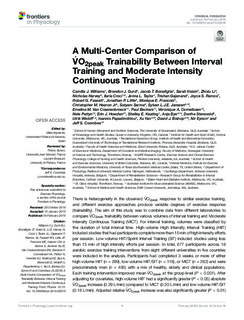| dc.contributor.author | Williams, Camilla J. | |
| dc.contributor.author | Gurd, Brendon J. | |
| dc.contributor.author | Bonafiglia, Jacob T. | |
| dc.contributor.author | Voisin, Sarah | |
| dc.contributor.author | Li, Zhixiu | |
| dc.contributor.author | Harvey, Nicholas | |
| dc.contributor.author | Croci, Ilaria | |
| dc.contributor.author | Taylor, Jenna L | |
| dc.contributor.author | Gajanand, Trishan | |
| dc.contributor.author | Ramos, Joyce S. | |
| dc.contributor.author | Fassett, Robert G. | |
| dc.contributor.author | Little, Jonathan P. | |
| dc.contributor.author | Francois, Monique E. | |
| dc.contributor.author | Hearon, Christopher M. | |
| dc.contributor.author | Sarma, Satyam | |
| dc.contributor.author | Janssen, Sylvan L.J.E. | |
| dc.contributor.author | Van Craenenbroeck, Emeline M. | |
| dc.contributor.author | Beckers, Paul | |
| dc.contributor.author | Cornelissen, Véronique A. | |
| dc.contributor.author | Pattyn, Nele | |
| dc.contributor.author | Howden, Erin J. | |
| dc.contributor.author | Keating, Shelley E. | |
| dc.contributor.author | Bye, Anja | |
| dc.contributor.author | Stensvold, Dorthe | |
| dc.contributor.author | Wisløff, Ulrik | |
| dc.contributor.author | Papadimitriou, Ioannis | |
| dc.contributor.author | Yan, Xu | |
| dc.contributor.author | Bishop, David J. | |
| dc.contributor.author | Eynon, Nir | |
| dc.contributor.author | Coombes, Jeff S. | |
| dc.date.accessioned | 2020-02-13T09:39:52Z | |
| dc.date.available | 2020-02-13T09:39:52Z | |
| dc.date.created | 2019-09-16T12:00:08Z | |
| dc.date.issued | 2019 | |
| dc.identifier.citation | Frontiers in Physiology. 2019, 10:19 1-13. | nb_NO |
| dc.identifier.issn | 1664-042X | |
| dc.identifier.uri | http://hdl.handle.net/11250/2641481 | |
| dc.description.abstract | There is heterogeneity in the observed VO2peak response to similar exercise training, and different exercise approaches produce variable degrees of exercise response (trainability). The aim of this study was to combine data from different laboratories to compare VO2peak trainability between various volumes of interval training and Moderate Intensity Continuous Training (MICT). For interval training, volumes were classified by the duration of total interval time. High-volume High Intensity Interval Training (HIIT) included studies that had participants complete more than 15 min of high intensity efforts per session. Low-volume HIIT/Sprint Interval Training (SIT) included studies using less than 15 min of high intensity efforts per session. In total, 677 participants across 18 aerobic exercise training interventions from eight different universities in five countries were included in the analysis. Participants had completed 3 weeks or more of either high-volume HIIT (n = 299), low-volume HIIT/SIT (n = 116), or MICT (n = 262) and were predominately men (n = 495) with a mix of healthy, elderly and clinical populations. Each training intervention improved mean VO2peak at the group level (P < 0.001). After adjusting for covariates, high-volume HIIT had a significantly greater (P < 0.05) absolute VO2peak increase (0.29 L/min) compared to MICT (0.20 L/min) and low-volume HIIT/SIT (0.18 L/min). Adjusted relative VO2peak increase was also significantly greater (P < 0.01) in high-volume HIIT (3.3 ml/kg/min) than MICT (2.4 ml/kg/min) and insignificantly greater (P = 0.09) than low-volume HIIT/SIT (2.5 mL/kg/min). Based on a high threshold for a likely response (technical error of measurement plus the minimal clinically important difference), high-volume HIIT had significantly more (P < 0.01) likely responders (31%) compared to low-volume HIIT/SIT (16%) and MICT (21%). Covariates such as age, sex, the individual study, population group, sessions per week, study duration and the average between pre and post VO2peak explained only 17.3% of the variance in VO2peak trainability. In conclusion, high-volume HIIT had more likely responders to improvements in VO2peak compared to low-volume HIIT/SIT and MICT. | nb_NO |
| dc.language.iso | eng | nb_NO |
| dc.publisher | Frontiers Media | nb_NO |
| dc.rights | Navngivelse 4.0 Internasjonal | * |
| dc.rights.uri | http://creativecommons.org/licenses/by/4.0/deed.no | * |
| dc.title | A multi-center comparison of vO2peak trainability between interval training and moderate intensity continuous training | nb_NO |
| dc.type | Journal article | nb_NO |
| dc.type | Peer reviewed | nb_NO |
| dc.description.version | publishedVersion | nb_NO |
| dc.source.pagenumber | 1-13 | nb_NO |
| dc.source.volume | 10:19 | nb_NO |
| dc.source.journal | Frontiers in Physiology | nb_NO |
| dc.identifier.doi | 10.3389/fphys.2019.00019 | |
| dc.identifier.cristin | 1725054 | |
| dc.description.localcode | © 2019 Williams, Gurd, Bonafiglia, Voisin, Li, Harvey, Croci, Taylor, Gajanand, Ramos, Fassett, Little, Francois, Hearon, Sarma, Janssen, Van Craenenbroeck, Beckers, Cornelissen, Pattyn, Howden, Keating, Bye, Stensvold, Wisloff, Papadimitriou, Yan, Bishop, Eynon and Coombes. This is an open-access article distributed under the terms of the Creative Commons Attribution License (CC BY). The use, distribution or reproduction in other forums is permitted, provided the original author(s) and the copyright owner(s) are credited and that the original publication in this journal is cited, in accordance with accepted academic practice. No use, distribution or reproduction is permitted which does not comply with these terms. | nb_NO |
| cristin.unitcode | 194,65,25,0 | |
| cristin.unitcode | 1920,26,0,0 | |
| cristin.unitname | Institutt for sirkulasjon og bildediagnostikk | |
| cristin.unitname | Sentral stab | |
| cristin.ispublished | true | |
| cristin.fulltext | original | |
| cristin.qualitycode | 1 | |

